Unraveling Tort and Crime

Editor: Matthew Dyson
Publisher: Cambridge, UK; New York: Cambridge University Press, 2014. 466p.
Reviewer: Youngjae Lee | March 2016
In the introductory chapter to this book of fourteen essays about the relationship between criminal law and tort law, editor Matthew Dyson writes that “[t]ort and crime are woven together in England in surprising, complex and under-researched ways” and that this collection “seeks to show how important, interesting and connected the law is” (p. 1). As these sentences suggest, the book is heavily doctrinal and most, though not all, of the chapters focus on English law.
One way to begin thinking about the relationship between tort law and criminal law is by seeing them as legal responses to wrongs. In his contribution, “Torts, Crimes, and Vindication: Whose Wrong Is It?,” R.A. Duff describes tort law as providing “a process through which one who has been wronged can bring a suit against the wrongdoer” and criminal law as enabling “a formal response to the alleged commission” of “wrongs that merit the policy’s formal condemnation” (pp. 148-49). The word “wrongs” appears in both descriptions, but do they mean the same thing?
One answer to this question is suggested by Duff in the same essay: “Criminal liability is liability for the culpable commission of a wrong, which merits condemnation and punishment,” and “[t]ort liability . . . is liability for the infringement of the claimant’s legally protected rights, which requires a formal acknowledgement and (if possible) remedy” (p. 155). Here is a similar formulation by G.R. Sullivan in his essay, “Wrongs and Responsibility for Wrongs in Crime and Tort”: “On retributivist principles, proof that D did or failed to avert some wrong for which he is culpable should be integral to any finding that D is guilty of a criminal offense” (p. 88), while “[t]ortious liability and a correlative duty to pay compensation is most straightforwardly explained when it can be depicted as an instance of corrective justice, a case of a duty placed on D to rectify the wrong that he has done to C” (p. 91). Kenneth Simons, in his essay, “Consent and Assumption of Risk in Tort and Criminal Law,” too, contrasts the two areas of law by describing a tort case as driven by “the plaintiff’s claim that the defendant has wronged him” and a criminal case as driven by “the state’s claim that the defendant deserves punishment,” which gives “much greater weight to the defendant’s subjective culpability than will a corrective justice account of tort law” (pp. 334-35).
These authors portray criminal law as focusing on whether a person is culpable and tort law as focusing on whether a person has wronged another person. Framing the difference between criminal and tort liability in terms of culpable wrongdoing on one hand and rights infringement on the other opens up a potential gap between the ways in which criminal law and tort law respond to wrongs. One could imagine tort law holding a person liable for infringing another person’s right but criminal law not holding the same person liable because he lacks culpability. One could also imagine criminal law holding a person liable for culpably committing a wrong but tort law not holding him liable because he did not wrong any particular person.
For example, as Duff discusses in his essay, tort law and criminal law may come apart in situations of mistaken self-defense. That is, where A attacks B under the mistaken impression that B was about to kill A, the two systems might have different responses. If A sincerely believed that B was attacking A, there is a case to be made that, even though A turned out to be wrong in his belief, he is not criminally culpable. On the other hand, given that B was in fact not attacking A, there is also a case to be made that, even though A is not culpable, A has wronged B by infringing on B’s rights (pp. 150-60). This is a case where there may be no criminal liability due to lack of culpability but there is tort liability due to A’s infringement of B’s rights.
Examples of the opposite scenario where there may be criminal liability but no tort liability can be found in Simons’ essay. Imagine that a person with a swimming pool in his house lets his neighbors use his swimming pool but has not communicated his permission to every neighbor. One of the neighbors, who does not realize that he has permission to use the pool and in fact believes that he does not have permission, uses the pool without first seeking permission from the owner. Simons says that “the privately consenting actor . . . has not been wronged,” which should “preclude tort recovery” (p. 338). On the other hand, there seems to be a solid case for an attempted trespass charge in criminal law for the trespasser whose disregard for other people’s property rights for his personal pleasure renders him culpable. Simons is careful to note that not all cases of “private, uncommunicated assent” preclude tort liability (pp. 344-45), but situations in which A does something to B without B’s permission, even though B in fact welcomes or permits it, seem like a promising place to investigate the possibility of there being criminal liability without corresponding tort liability.
Another way to consider the difference between criminal law and tort law is by contemplating, as Duff does in his essay, Blackstone’s formulation that tort law deals with injuries to “the civil rights which belong to individuals, considered merely as individuals,” whereas criminal law deals with public wrongs that are “breach and violation of the public rights and duties, due to the whole community, considered as community, in its social aggregate capacity” (p. 154). Looking at it this way requires that we separate private wrongs from public wrongs, and, as Duff notes, there is some plausibility to this separation (p. 162). Because tort law deals with private wrongs, the injured party gets to decide whether to pursue remedies, and, even if there is a genuine wrong recognized as such by tort law, once the victim declines to engage the legal system to seek redress from the wrongdoer, the state cannot intervene and open up a tort case on the victim’s behalf. Prosecutors, on the other hand, can at least in theory move forward with prosecutions even in cases where the victims do not want the state prosecution to proceed. Also, in tort law, a finding of liability typically leads to damages to compensate the victims for their injuries whereas a finding of criminal liability leads to punishment of the wrongdoer, which can end up leaving the victims out of the process altogether (p. 162).
Duff raises some questions about this picture, however. Even though the victims are not in control of the process in criminal cases, they nonetheless remain central to many prosecutions. In cases of single identifiable victims of crimes, prosecutors do not by default speak in abstract terms about injuries to the community but rather focus on the idea that a particular person has wronged another particular person (p. 163). Duff suggests that perhaps it is more normatively attractive to think of the state’s response to serious wrongdoing through the criminal process as being driven by the recognition “not just . . . that [the victims] have been wronged, but [we] must share in that wrong with them” and that “we must make the wrong not just his or her wrong, but our wrong” (p. 164). In other words, “we treat the wrong as done not (just) to the victim, but to us collectively” (p. 164). Reconceptualizing criminal law this way, Duff further suggests, points towards ways in which we might reform the criminal process in order to make the victim a more central part of it (pp. 168-69).
What Duff’s discussion here suggests is that we need not take the common view that criminal law addresses public wrongs and tort law addresses private wrongs as a fixed point. By thinking about the proper relationship between tort law and criminal law, we can increase or decrease the gap between the two areas of the law. Of course, rethinking criminal law and torts can go much further. For instance, can we even be confident of our starting point, that tort law and criminal law are responses to wrongs?
As Sullivan points out in his essay, the picture is complicated. Sullivan laments that there are “many criminal convictions” that “do not rest on any proof of a wrong” and there are also some that “dispense with proof of any responsibility for the identified wrong” (p. 91). Sullivan explains, for instance, that “[a] large part of the criminal law consists of victimless crimes, crimes which may be committed in the absence of any harm to V or wider interests, or even the threats of such harms,” that these crimes are “very often crimes of strict liability” (p. 97), and some of the strict liability offenses “can and are committed by persons who are blameless” (p. 89). Relaxation of the causation element and expansion of complicity and joint enterprise doctrines have also made “many persons fully liable for offences” even if they have not contributed causally to the ultimate outcome. (p. 107) This state of affairs surely challenges the view that criminal law addresses culpable wrongdoings only.
Tort law does not always seem to limit itself to wrongs either, according to Sullivan, as one can find instances where a defendant can be held liable for an injury simply because he caused it even if he is not at fault (pp. 94-95). There are even instances where a defendant is made liable for an injury even if there is no proof of causal connection between the plaintiff and the injury in question (p. 95) through recourse to expansive notions of vicarious liability or relaxation of the causation requirement that enables a finding of liability “based on market share or a more than minimal possibility” of contribution to the ultimate outcome (pp. 95 & 108-110). Such expansions of tort liability beyond wrongdoing “may be defended in terms of distributive justice” and “economic efficiency,” (p. 83) but Sullivan worries that these efforts may go too far and result in “a form of coercion to do good rather than any form of justice” (p. 95).
What this discussion shows is that neat theoretical distinctions between criminal law and tort law in terms of public and private wrongs may not hold up to scrutiny when tested against the messy reality. Legal scholars may then continue to study the messy reality, urge reforms along the lines of the best theories of criminal law or tort law, or revise their theories to match the reality, to mention a few options. This collection of essays is a good place to start on all of those fronts.
Youngjae Lee, Professor of Law, Fordham University School of Law


